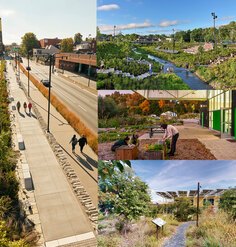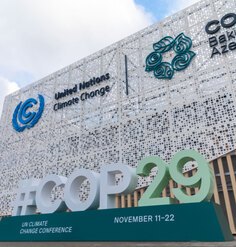From the Field: Exploring Performance Metrics from Downtown Boston to the Italian Countryside
By Jennifer Salazar, Ph.D. Candidate in Urban & Regional Planning and Victoria Chanse, Ph.D., Assistant Professor, University of Maryland
One of the many benefits of participating in the Case Study Investigation (CSI) program has been examining a variety of projects in order to develop metrics suitable for each one. As we’ve investigated and developed potential metrics, we’ve started to uncover some interesting lines of inquiry for theory and practice.
We’ve worked on three fascinating sites, each with a different design emphasis and unique landscape performance benefits. Some of the performance questions that we’ve tried to examine range from the social and economic dimensions (What is the value of green space in a dense urban area? What is the restorative benefit from views of greenery?) to the ecological (What benefits does a water feature in an urban plaza offer to birds?)
EDSA’s Castiglion del Bosco: Cultural Heritage and Tourism Benefits
The 45,000-acre Castiglion del Bosco in the Tuscany region of Italy is a UNESCO World Heritage Site that operates as a hotel, winery, and private member club. To document performance, we needed to understand and develop cultural preservation and tourism benefits. The distance, language barriers, and the fact that this is a private estate posed a number of challenges, not least of which was to quantify the conservation and restoration of a historic landscape along with the preservation of regional cultural traditions (including design traditions) related to land use and management. For insight on this, we turned to a variety of different resources, including information from the Sustainable Sites Initiative.
Reed Hilderbrand’s Central Wharf Plaza: A Tree Canopy Oasis
The Central Wharf Plaza offers a source of respite in a busy area of downtown Boston, Massachussetts. The tiny plaza’s 26 mixed-species oaks stand in marked contrast to the wide-open swath of nearly treeless parks that cover Boston’s infamous Big Dig. The plaza has been a major draw for downtown workers, student groups visiting the New England Aquarium, and tourists and commuters walking to nearby ferries. In evaluating performance, some of the challenges we're trying to quantify carbon sequestration and determine the variety of social benefits such as sitting, pedestrian circulation, occupant experiences, and benefits from views of the trees. Some of these challenges also applied to our third case study site described below.
Sasaki’s The Avenue: New Approaches to Urban Sustainability
This 2.6-acre site in the Foggy Bottom neighborhood of Washington, DC is a model of transit-oriented development and beautiful, innovative stormwater management design. At a system scale, the project functions well in terms of stormwater collection, wide sidewalks for the high volume of pedestrians, and a beautiful courtyard space with an iconic water feature. At the scale of the plaza, are the more difficult-to-measure but important-to-consider landscape performance benefits. Sounds of the small fountain, cooler areas by the water, and green space provide a wonderful respite from the urban intensity of the adjacent university, hospital, and Metro station. The surprising number of small birds (not pigeons) also add to the experience of the small plaza.
CSI has been a great experience in terms of investigating and exploring which performance metrics are most measurable and useful in assessing a site. The collaboration between academic research and landscape architecture practice is invaluable — it was great to get out and measure how built projects are actually performing and to learn first-hand about the challenges firms face when implementing sustainable design practices.
Professor Victoria Chanse and student Research Assistant Jennifer Salazar are participating in LAF’s 2012 Case Study Investigation (CSI) program and working to quantify the landscape performance benefits at three diverse project sites. Any opinions expressed in this article belong solely to the author. Their inclusion in this article does not reflect endorsement by LAF.











